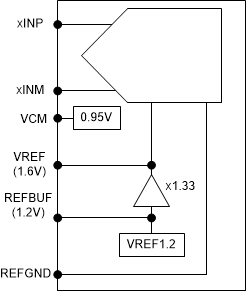SBAS886A October 2020 – May 2022 ADC3641 , ADC3642 , ADC3643
PRODUCTION DATA
- 1 Features
- 2 Applications
- 3 Description
- 4 Revision History
- 5 Pin Configuration and Functions
-
6 Specifications
- 6.1 Absolute Maximum Ratings
- 6.2 ESD Ratings
- 6.3 Recommended Operating Conditions
- 6.4 Thermal Information
- 6.5 Electrical Characteristics - Power Consumption
- 6.6 Electrical Characteristics - DC Specifications
- 6.7 Electrical Characteristics - AC Specifications ADC3641
- 6.8 Electrical Characteristics - AC Specifications ADC3642
- 6.9 Electrical Characteristics - AC Specifications ADC3643
- 6.10 Timing Requirements
- 6.11 Typical Characteristics - ADC3641
- 6.12 Typical Characteristics - ADC3642
- 6.13 Typical Characteristics - ADC3643
- 7 Parameter Measurement Information
- 8 Detailed Description
- 9 Application and Implementation
- 10Device and Documentation Support
- 11Mechanical, Packaging, and Orderable Information
Package Options
Mechanical Data (Package|Pins)
- RSB|40
Thermal pad, mechanical data (Package|Pins)
- RSB|40
Orderable Information
8.3.3 Voltage Reference
The ADC364x provides three different options for supplying the voltage reference to the ADC. An external 1.6 V reference can be directly connected to the VREF input; a voltage 1.2 V reference can be connected to the REFBUF input using the internal gain buffer or the internal 1.2 V reference can be enabled to generate a 1.6 V reference voltage. For best performance, the reference noise should be filtered by connecting a 10 μF and a 0.1 μF ceramic bypass capacitor to the VREF pin. The internal reference circuitry of the ADC364x is shown in Figure 8-16.
Note: The voltage reference mode can be
selected using SPI writes or by using the REFBUF pin (default) as a control pin (Section 8.5.1).If the REFBUF pin is not used for
configuration, the REFBUF pin should be connected to AVDD (even though the REFBUF pin has
a weak internal pullup to AVDD) and the voltage reference option has to be selected using
the SPI interface.
 Figure 8-16 Different voltage reference options for ADC364x
Figure 8-16 Different voltage reference options for ADC364x